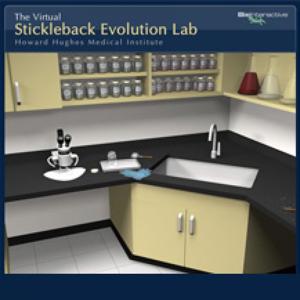Stickleback Evolution Virtual Lab
| Record number: | 2d80f |
|---|---|
| Category: | Biology |
| Type: | Computer Program - App |

Stickleback Evolution Virtual Lab is an interactive, modular lab explores how stickleback fish and fossil specimens are used to study evolutionary processes, with an emphasis on data collection and analysis.
In this lab, students learn and apply techniques for analyzing the forms and structures of organisms — in particular, the pelvic structures of the threespine stickleback fish (Gasterosteus aculeatus), a model organism for studying evolution. The lab includes three modules in which students collect and analyze data using photographs of living fish specimens and fossils. Throughout this lab, students engage in key science practices, including making quantitative measurements, graphing data, and performing statistical analyses.
The lab contains an interactive lab space, an informational notebook, videos, and embedded quiz questions. It also includes supplementary resources, such as a glossary of scientific terms and a list of references.
The accompanying handouts provide structure and guidance as students perform the tutorials, experiments, and quizzes in the lab. The only difference between the “Basic” and “Advanced” versions of the handout is that the “Basic” version does not include the parts of the lab with chi-square analyses. The “Teacher Materials” provides background information, tips for using the virtual lab, and an answer key for the student handouts.
Student Learning Targets:
- Collect and analyze data to quantify phenotypic diversity among populations.
- Compare fossils and living organisms.
- Explain how natural selection can drive the evolution of complex traits, such as the size and shape of skeletons.
- Formulate hypotheses about selective pressures in different environments.
- Use statistical analyses to gauge confidence in conclusions drawn from population data.
Materials:
- Student Handout—Advanced (PDF) 158 KB
- Student Handout—Basic (PDF) 138 KB
- Teacher Materials (PDF) 215 KB
- iOS App - iPad (Link) 277.1 MB
Please see other Virtual Lab Series from BioInteractive:
- Lizard Evolution Virtual Lab
- Coloration in Vertebrates
- Cardiology Virtual Lab
- Neurophysiology Virtual Lab
- Stickleback Evolution Virtual Lab
For comparison please see Virtual Physiology Series.
Access online.
Takk for din tilbakemelding! Vær oppmerksom på at vi ikke kan kontakte deg hvis ikke du oppgir din epostadresse.
Hva lette du etter?
Gi oss gjerne en tilbakemelding slik at vi kan forbedre informasjonen på siden. På forhånd takk for hjelpen! Vennligst skriv inn din epostadresse hvis du vil ha et svar.
Kontakt oss gjerne på e-post hvis du har spørsmål.
